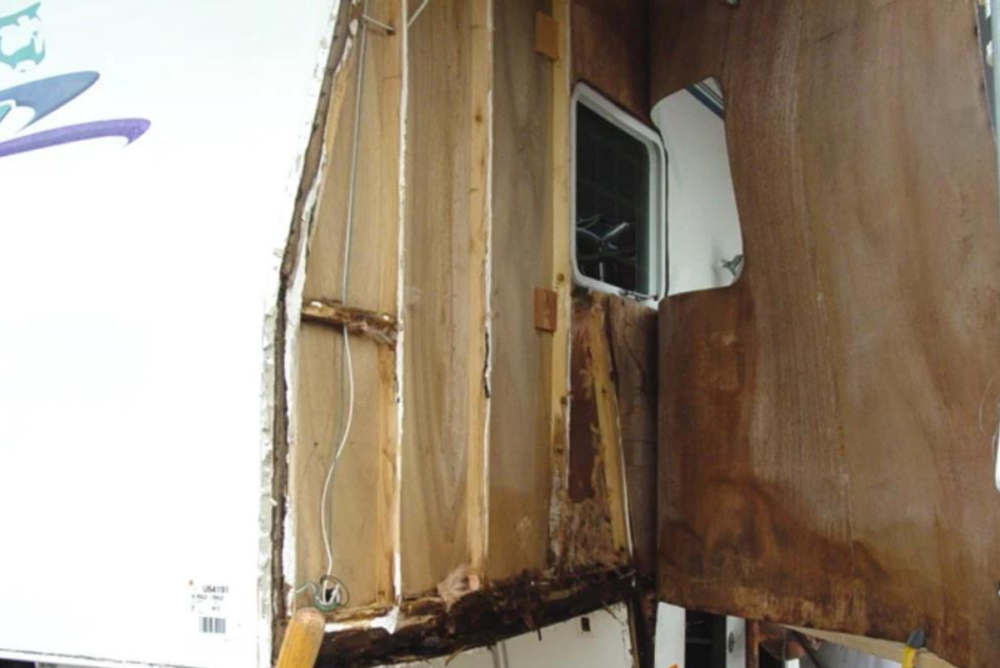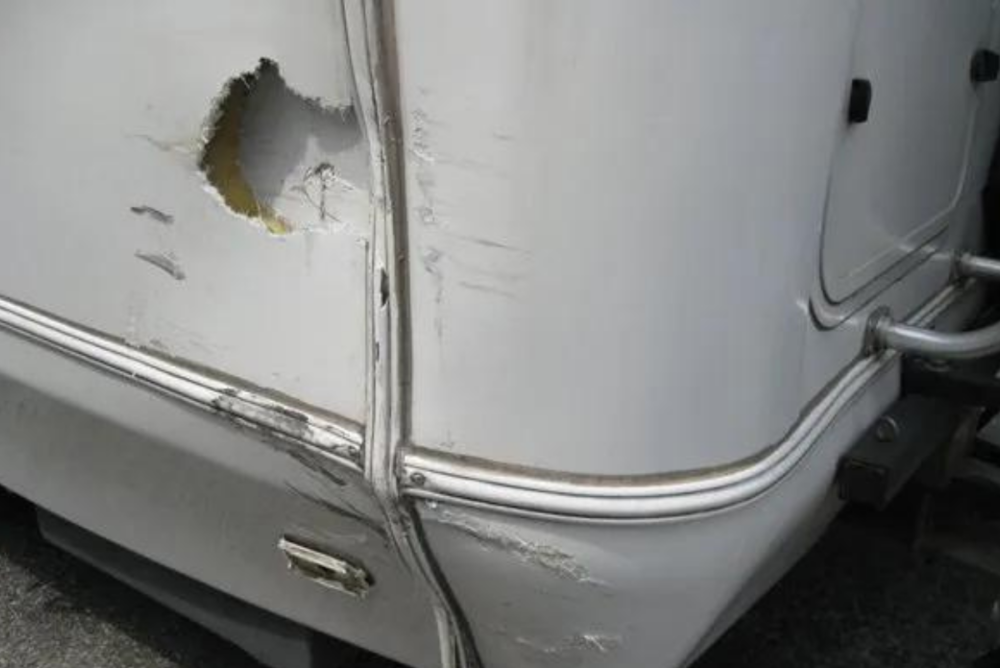How do you inspect an RV for delamination?
Delamination can potentially be the end of your RV’s life if the damage is serious enough. Catching delamination early can help save your RV from expensive, time-consuming repairs. Is it too late for your RV?
Delamination often doesn’t show itself until it’s been happening for a while. For this reason, it is a silent killer of RVs. The tricky thing with delamination is that it happens behind the exterior layer of your RV, making it invisible until signs start to show.
Unfortunately, once it’s noticeable, the damage has been done, resulting in huge repair bills that in some cases won’t be worth it. Knowing signs to look for and what action to take should your RV have issues can save your RV.
What is delamination?
Most modern RVs use fiberglass as the exterior layer. It is smooth, can easily be formed, and is pretty durable. The fiberglass layer is bonded to the layer underneath, which is generally plywood and styrofoam. The bonding agent secures the fiberglass to the backing, essentially forming a solid piece.
Delamination occurs when the bonding agent is compromised and the fiberglass exterior layer begins to separate from the backing layer. At first, this likely won’t be obvious, as both the exterior and interior surfaces of the RV will still look fine. Between the layers, however, major problems are starting to happen.
Delamination can occur for multiple reasons, which we will dive deeper into. Regardless of the reason for delamination, it’s a serious problem that can be avoided in most cases and needs to be dealt with quickly and properly!

What causes RV delamination?
With the bonding agent sealed between the exterior and interior layers, it seems unlikely that it would be affected by much. While this is true, there are a few ways the bond can be compromised, resulting in delamination.
Failure of exterior seals
This is the most common reason for RV delamination, which is unfortunate because it’s also the most avoidable. RV exteriors are full of seals to weatherproof so your RV is watertight.
Windows, doors, vents, and any place where something passes through the exterior of the RV have a seal. Caulking, silicon, and butyl tape are the most common seals used for their moisture-blocking characteristics. These seals can dry out, crack, and shrink causing leaks.
When a leak on the exterior begins, the water can work its way between the fiberglass and backing layers. This results in the bonding agent failing, and the fiberglass layer will start to separate from the backing.
Damage to the fiberglass shell
The impact from tree branches or from coming in contact with something while maneuvering into that tight spot can break through the fiberglass exterior and start the delamination process. Any crack or chip in the fiberglass will allow moisture to get behind it and start working away at the bond.
Damage to the fiberglass on an RV can be extremely frustrating. It’s important not to forget about what may have happened under the fiberglass as well.
Aside from water making its way in, it is also possible that the impact broke a section of the bond. This can result in having a hollow spot between the layers, causing warping or a bubble.

Manufacturer construction issues
It isn’t very common to have fiberglass delamination from the factory; however, it can happen. RVs are constructed by hand and quality is a reality. The manufacturer of the bonding agent may also be at fault if there is a bad batch of products.
There are some ways to check for delamination areas that we will discuss, and it’s a good idea to check your RV even if it’s brand new. Checking seals on new RVs is also a good idea for the same reasons involving human error and product failure.
Signs that your RV may have delamination
The key to delamination is catching it ASAP! The longer moisture is able to eat away at the bonding agent, the larger area of delamination you will have. Similarly, if delamination starts from an impact causing the fiberglass layer to separate, the constant jarring of the RV while traveling will continue to break areas loose.
Anytime there is a break in the fiberglass, there is the possibility of delamination. That being said, as soon as a crack or damage is noticed, you should investigate further. The same goes for exterior seals that are missing or damaged. If there is any area where water could have gotten behind the fiberglass, there is a possibility of delamination.
The above are situations where you should be cautious about possible delamination. However, there are some warning signs that mean delamination is already present and needs to be dealt with.
Signs of more serious damage
Warping or bubbles in your RV are a red flag that something is happening under the fiberglass. As mentioned above, it is a good idea to check your RV when new for any suspect areas so you know if it is something new or not. If you have any areas with raised fiberglass, check the seals in that general area for possible leaks.
On the other hand, if you find a bad seal somewhere and you’re worried about delamination starting as a result, there are some checks you can do. The first is a visual looking for the above-mentioned warping or bubbles. Raised fiberglass isn’t always going to be present though, so you need to inspect it further.
If you have ever checked a wall looking for a stud by banging on the drywall, you’ll be familiar with this technique. Using something that won’t damage the RV, like a plastic mallet, tap the suspect area in multiple places. Properly bonded fiberglass will be solidly connected to its backing, resulting in a solid sound. If there is separation, you will hear a more hollow sound.
In this situation, it’s a good idea to have an RV technician check the area for confirmation. If delamination is present, you will then have to determine the extent of the damage and plan repairs.
Can RV delamination be easily fixed?
Everything can be fixed given enough time and money, but is delamination a realistic repair? This will depend on the extent of the damage and the value of your RV. Because delamination is hidden, it can be tricky to determine just how bad it is. Combine this with the fact that there may also be mold starting as a result of moisture, and it can become a very big problem.
For small cracks or damage from impact, DIY repair kits for fiberglass are available. If you notice minor damage right away, before the moisture has a chance to enter, these kits can do the trick. You will want to make sure the area is properly prepared and there is no moisture. There are DIY kits for larger delamination repairs, but you will want to be sure of your ability to do the repair.
If the area has been exposed for a longer period, simply covering it up may not be the answer. Moisture that has entered may have started mold, which will continue to spread after you cover up the area. In some situations, you may be able to get a look behind interior walls by removing wall paneling. This isn’t a guarantee, but if serious mold is present, it may be starting to show signs on the backside of the exterior layer.
Know when to call the pros
If you have warping or bubbles in the fiberglass, in most cases, this is going to require a pro. Finding the leak area and sealing it isn’t going to stop the delamination from spreading. Fiberglass work in areas larger than small cracks takes special tools and experience.
In some situations, entire exterior panels will need to be removed and replaced. This is a time-consuming and expensive repair. Your RV may not be worth the cost to repair unfortunately, and you will have to weigh your options. One thing to note is that if you decide your RV is not worth the repair costs, and you will just use it as-is until it’s unusable, mold may be present along with the delamination.
Don’t let delamination ruin your RV
RV delamination repair costs can quickly exceed RV value, making it one of the more serious problems you can have. Regular inspection of exterior seals and resealing will eliminate most delamination scenarios. Take the time to do a full check of your RV exterior, including the roof for leak locations, at least once a year.
Proceed carefully if you suspect you are buying an RV with delamination repairs.
Exterior damage can’t always be avoided, but when it does happen, fix your fiberglass immediately! Repairing cracks and chips before the water gets in is the key. If the fiberglass work required is more than a DIY epoxy kit can handle, take it to a pro.
Track your RV maintenance
Make sure you keep track of all your RV maintenance and repairs with an online tool such as RV LIFE Maintenance. Not only can you keep all of your documents in one place, but you’ll also receive timely reminders when maintenance is due to help you avoid costly repairs and potentially serious accidents.
Continue reading:



